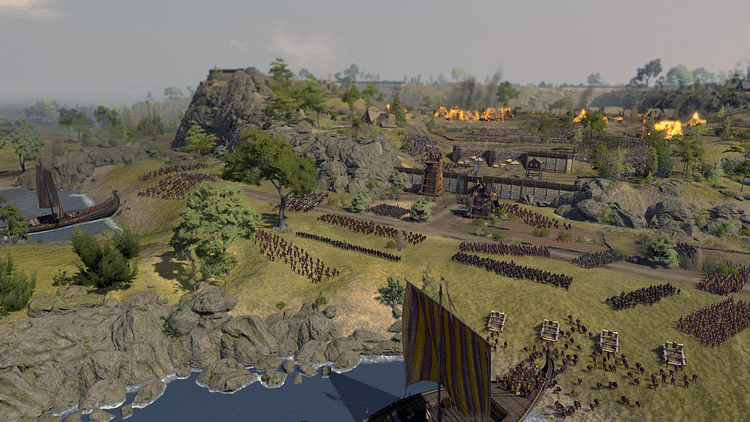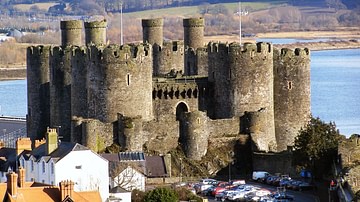The Norse may have ruled parts of northern Wales in the early 11th century, specifically in Anglesey and Gwynedd, though the degree to which is unclear. Old Norse had relatively little impact on Welsh linguistics, and the Old Norse influenced or derived place names are mostly restricted to coastal regions, where raiding was most common.

Viking Raids in Wales
The first phase of Viking raids in Wales began c. 850. The Chronicle of the Princes (Brut y Tywysogion) records an attack on Wales in this year in which one Cyngen, a Welshman, was "strangled by the Pagans" (Brut y Tywysogion, 13). The Chronicle also records an attack c. 853 on Mona, the Latin name for Anglesey, in which the island was destroyed by pagans. Rhodri Mawr, the ruler of Gwynedd, led a successful resistance against the Norse, and around 855-856, he killed a Viking leader by the name of Orm who came from Dublin. In 877 CE, the Annals of Ulster records that Rhodri "came in flight from the dark foreigners to Ireland" (334). This was likely part of the same group (described in Irish annals as "dark foreigners") to which Orm, killed by Rhodri some 20 years prior, had belonged. Rhodri returned a year later in 878 to defeat the Vikings on Anglesey. Later that same year, both Rhodri and his son Gwiard were killed by the Saxons attempting to expand into Gwynedd. The Annales Cambriae also records a raid in 895.
Given the activity of the Dublin-based Vikings in northern Wales, and the claim by Welsh writer Asser that Rhodri Mawr's sons were dependent on the Scandinavians of York, a case for Viking dominance over north Wales by the 870s has been made. Viking interest in Anglesey is further demonstrated by the activity of the Viking leader Ingmund. Expelled from Dublin c. 902 for unknown reasons, Ingmund arrived on Anglesey with his men and attempted to establish a base there. The Annales Cambriae records that Ingmund captured a place called Maes Osfeilion, but before he could establish a permanent foothold on Anglesey, he was expelled by the Welsh king, and he and his men were given permission to settle near Chester in England. Also around this time, c. 902/903, the Annales Cambriae records that another of Rhodri Mawr's sons, Merfyn ap Rhodri was killed by pagans.
A second phase of Viking activity in Wales began c. 950 when the Vikings looked towards coastal lowland areas for attack. In the latter half of the 10th century, monasteries at Penmon and Caer Gybi on Anglesey, Tywyn (in Gwynedd), St. David's, Clynnog Fawr, St. Dogmaels in Pembrokeshire, Llanbadarn Fawr in Ceredigion, and Llantwit Major and Llancarfan in the Vale of Glamorgan were raided. In 989, Maredudd ab Owain, great-great-grandson of Rhodri Mawr, paid a group of Vikings a penny per head in exchange for Welshman they had captured and taken into slavery during their raids.
Occasionally there was cooperation between the Vikings and the Welsh, so long as the Welsh paid the Vikings enough for their services. Around 990/991, Maredudd hired a group of Vikings willing to join him in attacking Glamorgan. In 991, the Brut records an attack on Anglesey by pagans once again, this time on Ascension Thursday. In 999, the Vikings "depopulated" Menevia (a Catholic diocese in South Wales) and killed Bishop Morgenau. It was also in this year that Maredudd ab Owain, "the most celebrated king of the Britons," died. In 1000, the kingdom of Dyfed was raided by the Vikings (Brut y Tywysogion, 33).

A third phase of raiding and Viking activity appears to have taken place in the 11th century. During this period, Viking presence in the Severn Estuary (flowing into the Bristol Channel between southwest England and south Wales) increased. One account from this period recalls how Count Eilaf, a Dane in the service of King Cnut, plundered Glamorgan in south Wales. The clergy from the monastery St. Cadog in the village of Llancarfan fled with holy relics and the shrine of St. Cadog, only to be attacked yet again by Vikings, this time at Mamhilad in Monmouthshire; one of the attackers apparently even damaged the shrine of St. Cadog with his axe.
During this period, the Welsh occasionally employed the Vikings as allies or mercenaries and used them in their own political struggles. Contending for the throne of Deheubarth, Gruffudd ap Llywelyn (l. 1010-1063), the king of Gwynedd and Powys, found himself on the receiving end of an assault by a Danish fleet led by a fellow Welshman named Hywel ab Edwin in 1044 at Aber Tywi. It was Hywel's final attempt to keep his kingdom after he had been driven out of Deheubarth by Gruffudd a year before. The Brut records that Gruffudd was captured by the "Pagans of Dublin" (Brut y Tywysogion, 41).
Vikings and Welsh fought together again c. 1055, when an alliance between Gruffudd and Aelfgar, Earl of the Anglo-Saxon kingdom of East Anglia, who had been exiled on charges of treason, sacked Hereford with the help of a fleet of 18 Viking ships from Dublin (Lloyd, 365). They marched on the city on 24 October. It was a disastrous defeat for the defenders, led by Ralph the Timid, Earl of Hereford (d. c. 1057); they were quickly routed, and the combined forces of Welsh, Anglo-Saxons, and Vikings pillaged and destroyed the city. The new cathedral built by Bishop Athelstan was looted, and seven of the clergymen were killed. Captives and plunder were carried off back to Wales and the city was left burning.
Finally, the 10h-century Welsh poem Armes Prydein Fawr ("The Great Prophecy of Britain") describes a future in which the Welsh ("Men of Cymry' in the poem) are united with the Irish, Scots, and Norse from Dublin in driving out the Anglo-Saxons from Britain forever. According to the Armes, the original Saxon mercenaries led by the brothers Hengist and Horsa had acted in deceit when they betrayed Vortigern, king of the Britons, who had requested the brothers' help in defending against the Picts from Scotland. Vortigern had given Hengist and Horsa land on the Isle of Thanet, wrongfully assuming that they would leave once the Picts were taken care of. Instead, the brothers invited more Saxons to sail over and settle and demanded that their monthly allotment be increased. When Vortigern refused, the brothers revolted and formed the first Saxon kingdom in Kent.
The Armes Prydein Fawr claims that the tribute demanded from the Welsh by the Anglo-Saxons is unjust and the Anglo-Saxons had no right to the lands of Britain, either by inheritance or by law, given Hengist and Horsa's betrayal of Vortigern. While the Armes foretells a future in which the Welsh, Irish, Scots, and Norse reconcile, it has no interest in the goals of any group other than the Welsh. It simply states that such an alliance will happen, and the end result is an end to the tribute and the expulsion of the Anglo-Saxons from Britain.
Norse Place Names & Settlement in Wales
Norse place names preserved in Wales are either visual navigational points, typically along coastlines, or Scandinavian-style settlement names combined with personal names. For the first group, the suffix -holmr (meaning "islet" or "island") is common, reflected in place names such as Priestholm, Grassholm, Skokholm, Gateholm, Burry Holms, Flat Holm, and Steep Holm. Flat Holm was known to the Saxons as Braden Relice, meaning "broad burial place". According to The Anglo-Saxon Chronicle the Danish noblewoman Gytha Thorkelsdóttir (c. 997-1069), mother of the last crowned Anglo-Saxon king Harold Godwinson (c. 1022-1066), used Flat Holm as a place of refuge after the Norman conquest of England before departing for St. Omer in France. More than a century earlier, in 914, a group of Vikings led by the earls Hróald and Óttar fled from Flat Holm to Steep Holm (Steapan Relice or "steep burial place" to the Saxons) where many died from hunger.
Place names such as Fishguard, the Skerries (sker meaning "isolated rock"), Emsger, Tusker, The Stacks (stakkr meaning "pillar-shaped rock"), Stackpole, Midland (from Old Norse meðal, or "middle," and -holmr), and Orms Head (ormr meaning "snake") are also of Norse origin. Anglesey, Bardsey, Caldy, Skomer (skálm meaning "side of a cleft," and -ey), Ramsey, and Lundy preserved the ending -ey, Norse for "island".
Examples of Scandinavian-style settlement names with personal names added include Furzton, Haroldston, and Yerbston in Pembrokeshire. These names are made up of a Scandinavian personal name followed by the Anglo-Saxon ending of -tun. Names like Goultrop, Hasguard, Wolf's Castle, and Scollock from Pembrokeshire may also reflect Norse influence. For the most part, Scandinavian place names occur in coastal regions where Norse influence and activity were stronger. Though Norse place names of coastal regions such as Bardsey, Anglesey, and Orme's Head have moved into English, their Welsh names, Ynys Enlli, Môn, and Penygogarth respectively, have remained intact. Welsh vocabulary was hardly affected by Old Norse, and the fact that there is little linguistic relationship between the Welsh names of these regions and the Norse names suggests little Norse involvement with the native Welsh population.
Archaeological Evidence
Compared to England or Ireland, there is relatively little in the way of Norse archaeological finds in Wales, reflecting the lesser degree of Viking activity in Wales. Still, certain finds do support what we know from historical records and place names. The five silver arm bands found in Red Wharf Bay are one such example. It is highly likely that they were deposited by Scandinavians and either had an economic function or were used as a way to confer status onto recipients via gift-giving. It has been suggested that the activity of the Viking leader Ingmund on Anglesey has directly led to the deposition and non-recovery of these five armbands.
Eleven Norse silver hoards have been found in Wales, likely deposited between 850 and 1030. Of the two hoards found in Bangor, Gwynedd, one was probably deposited after 925 and contains a mix of coins and hack-silver; it may indicate east-to-west or west-to-east movement of bullion. There was also the discovery of a sword guard found by a diver off the coast of Pembrokeshire at Smalls Reef. The lower guard is composed of brass and silver and depicts various beasts and snake-like animals.
Four possible Viking Age Scandinavian burials have been located, all along the coast. Two of them, Talacre in Flintshire and Benllech on Anglesey, contained skeletons and grave goods, the third is proposed as a context for a pair of stirrups from the late 9th or early 10th century at St. Mary Hill in the Vale of Glamorgan, while the fourth is a late 10th- or early 11th-century spear and axe find.
Excavations by the National Museum of Wales have also revealed the site of a fortified settlement on the coast of Anglesey at Llanbedrgoch. This settlement was linked with others around the Irish Sea in social and economic exchange. Artefacts found at the site are typical of the Norse or Irish Sea style, while others are the native Irish type. The discovery of hack-silver demonstrates an active bullion economy, while items meant for personal adornment have close similarities to those found at Dublin, Meols, York, and Whithorn.
Legacy
While Wales suffered from a series of raids on its coastal regions throughout the Viking Age, there was no permanent and long-lasting Viking settlement. Viking leaders such as Ingmund and Orm may have attempted to establish a foothold on Anglesey, but while the Vikings in Ireland had Dublin as their base, no such centre exists in Wales. Certain place names, mostly along the coastline, suggest Norse influence, but Old Norse had no lasting impact on Welsh.









